How Everesting became a worldwide cycling phenomenon
A cyclist rides up a hill — and repeats until he reaches the height of Everest. Then he does it 99 more times. The fad that’s become a global phenomenon.
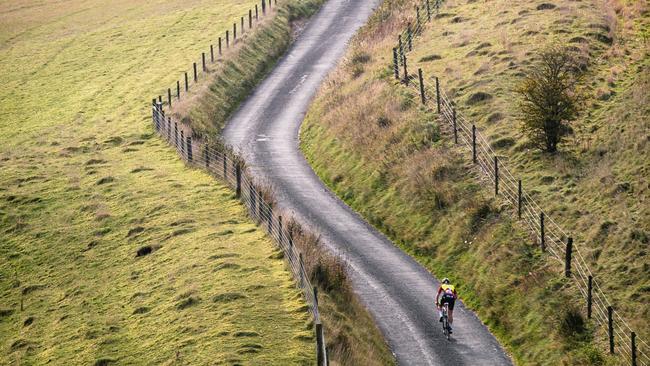
“I am filled with a desire for clarity and meaning within a world and condition that offers neither.”
Albert Camus, The Myth of Sisyphus
Sisyphus pushed the same stone up a long and unforgiving hill endlessly, only to see it roll back to the bottom each time, because he was condemned to by the gods. Jonathan “Jono” Egan, the Sisyphus of cycling, rides up and down the same hill or mountain for 12 or 13 hours at a time, sometimes twice in the same week, simply because he can.
Egan has become the emperor, poster boy and unofficial world champion of the strange cycling phenomenon known as Everesting, a cruel and unusual pursuit that gained a perverse kind of cachet in the plague year. The rules are simple but there’s nothing easy about the challenge. You pick one hill, any hill, and ride up and down it repeatedly until you hit the height of Mount Everest – 8848.86m at last count (the world’s tallest mountain is still growing). You can take short breaks to eat and drink, but you are not allowed to sleep until it’s done.
The tall, wiry children’s intensive care doctor who divides his time between Sydney and Adelaide has notched up his 100th Everesting at the time of writing, a singular milestone and a feat of endurance, commitment and sheer bloody-mindedness unlikely to ever be equalled – or even attempted. Egan has done them on some of Australian cycling’s most celebrated climbs, and on the most anonymous suburban streets, on hills long and short, steep and shallow. He has done them on tarmac, gravel and even grass. And accompanying each episode of this temporary insanity, the overarching question, the philosophical conundrum, the great flashing neon question mark blinking above his close-cropped head is … why?
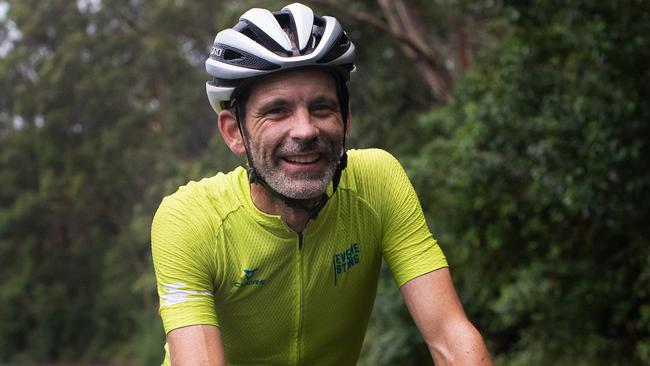
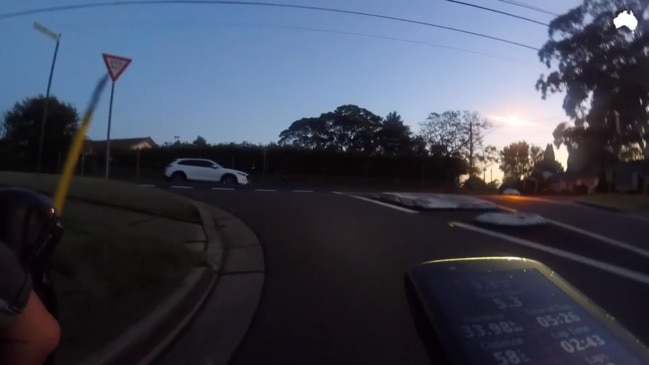
Don’t expect any glib answers from the man himself. Egan, 50, takes self-effacing to extremes. A man of few words, he seems as mystified as the next guy as to how he has managed to endure and even enjoy this masochistic pursuit. Like Camus, he seems to have reached the conclusion that true happiness and meaning can only be found in the quiet acceptance of suffering and that satisfaction resides within the performing of the allotted task. The Myth of Sisyphus finds Camus preoccupied with the absurd; the fundamental conflict between what we want from the universe (meaning, order, or reasons) and the entropic chaos we find instead. Camus claims Sisyphus as his ideal absurd hero and avatar of the human condition; as long as he accepts that there is nothing more to life than absurd struggle, then he can find happiness in it.
When I catch up with Egan about two-thirds into his 96th Everesting on the quiet, short and steep Florence Ave in Sydney’s northwestern suburb of Denistone, he seems at peace with the struggle. For me, trying to ride a few repeats with him at his pace veers firmly into theatre of the absurd. After six times up and down the hill (400m, with an average gradient of 11 per cent but steeper pinches) at the speed Egan will keep up for close to 13 hours and some 206 repeats, my legs are burning and I’m gasping for breath. My plan had been to interview him as we rode, but after the first lap my words come in short, staccato bursts. Egan is settled into a steady rhythm, a smooth and efficient pedal stroke giving way to short bursts out of the saddle to share the load between muscle groups and to take a load off the nether regions. He has an almost beatific air about him, an athlete truly in the zone.
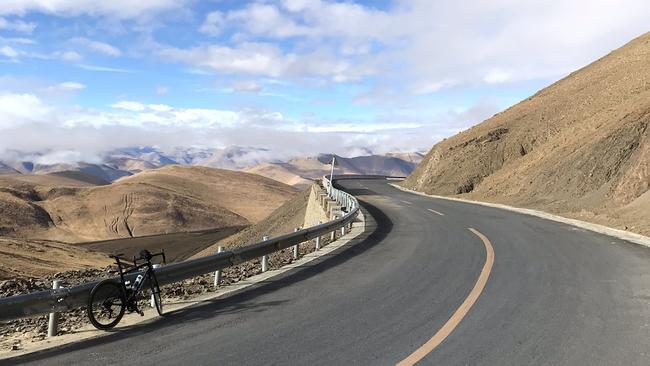
The official website of Everesting, along with its hall of fame, is overseen by a mysterious band of monk-like adepts who call themselves the Hells 500. “It all started,” the website (everesting.cc) says, “with a bunch of guys who liked riding in the hills. Too much. We liked the fact that as hill riders we were on the fringe, so rather than race we would set ourselves goals that no one else was doing. The prerequisite for any challenge that we set was that it had to be tough. To qualify, it needed to be too difficult to just go out and ride it. We would spend months training up for each new epic – usually timed with the onset of spring. This meant that the crux of our training every year was undertaken in the cold, dark, wet winters when everyone else would stay under the doona.”
The numbers tell the story of how the practice has grown in popularity since its inception in 2014. At the time of writing, there have been 14,453 successful Everestings in 98 countries, with 122,068,380 vertical metres climbed and 4,972,619km ridden. Accompanying the statistics are quotes from riders whose names are inscribed in the Hall of Fame, riders accustomed to putting themselves through the weeks of torture that are cycling’s grand tours:
The hardest thing I have done on a bike, purely because I depleted myself. – Greg Henderson.
There’s vomit in my beard but this suffering is a privilege. – Phil Gaimon.
I take my hat off to whoever has completed it in whatever capacity. It was grim. – Mark Cavendish
Everesting was well-known in cycling circles but came to wider public attention during the height of the coronavirus pandemic when bored pro cyclists went in search of hills when the world tour was shut down. Suddenly an Everesting arms race exploded as some of the fittest athletes on the planet sought to leave their mark on the summit. Like Everest’s death zone awash with queues of climbers, hills were suddenly dotted with Lycra warriors on a quest for glory, keen to stand astride cycling’s summit.
In May last year, Australian pro rider with Education First Lachlan Morton became the third person in a month to set a speed record for Everesting. On May 11, retired US pro Phil Gaimon was first to break the eight-hour barrier, but his mark lasted just four days, broken by US mountain biker Keegan Swenson in Utah, who completed an Everest in 7:40:05. Morton upped the ante on June 13 on a hill in Rist Canyon, near Fort Collins, Colorado, with a time of 7:29:57. “The section I was riding was about a mile and it had 200m of elevation gain. And so I had to do 47 laps. And each lap was more or less 10 minutes,” he explains. It was his second attempt in a week; on June 13, he completed “42 laps of hell” on the same hill only to discover his cycling computer had malfunctioned and left him 1500m short of the required height.
Morton’s mark was pipped by Spanish legend Alberto Contador, who in turn was usurped by Irish cyclist Ronan McLaughlin in July last year. McLaughlin’s time of 7:04:41 smashed Contador’s mark by 20 minutes, done on the climb of Mamore Gap in County Donegal, northwestern Ireland, a climb with a crippling average gradient of 14 per cent and a descent that allowed the rider to reach speeds of 86.5km/h.
Former British professional rider and now presenter for the popular Global Cycling Network channel Emma Pooley holds the women’s record. On July 8 last year she took on 10 laps of the 6.7km, 13 per cent average gradient Haggenegg climb in Switzerland, completing the effort in 8 hours, 53 minutes and 36 seconds. “It was both terrible and fantastic, sometimes simultaneously. Never ever ever again,” she said afterwards.
While the pros were trading blows, US endurance cyclist Logan Kasper carved out his own place on the summit, completing four Everesting rides in seven days on hills in New York and Massachusetts, cycling more than 1285km and ascending 36,218 vertical metres in June last year. “A month before the ride a dumb but fun idea popped into my head to go for three Everestings in one week,” he said. “Midday on the third Everesting another funky idea popped in my head to do a fourth. Why? Because why not.”
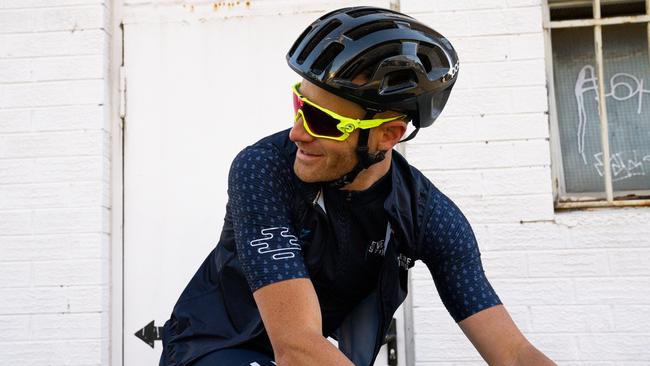
Some 1200 riders around the planet recorded successful Everestings in May last year, as interest in the practice peaked, according to Melbourne’s Andy van Bergen, the voice of the Hells 500 and the bloke who popularised the concept. “It’s entered the cycling lexicon,” he says. “The coolest thing is that there’s no longer any explainer needed. You say the word, and people know what it is.”
Van Bergen, whose day job is in sales at cycling website Cycling Tips, says he was inspired by George Mallory – grandson of Everest mountain climber George Mallory – who in 1994 rode the required 8848m on Mount Donna Buang in Victoria to train for an actual climbing ascent of the real mountain. This percolated in the back of van Bergen’s mind while he pushed to complete ever more ridiculous feats of cycling endurance with his close-knit band of fellow two-wheeled hard men and women. “The biggest ride I did up to that point was 300km with 6500m of climbing, and I went into my office and told a friend about it and the guy literally was like, ‘Oh, that’s nice, what else did you do?’ ” he says. “I trained a year for this. It’s the hardest physical thing I’ve ever done and you’re asking me what else I got up to?”
That was followed by a ride that took on Peaks Challenge (an annual 235km ride that takes in Tawonga Gap, Mount Hotham and Falls Creek) forwards and then backwards, with Mt Buffalo thrown in for good measure, giving rise to the Hells 500 High Rouleur’s Society (10,000m of climbing and 500km in a single ride). But van Bergen wanted a challenge even the non-cyclist could relate to. He recalled Mallory’s ride, a light bulb flicked on and Everesting was born. “It’s a beautiful connection from George Mallory and his own feats on the mountain as well as his grandfather’s. I ran the idea by him and he was really supportive. And it’s just gathered its own momentum since then.”
Van Bergen and his wife Tammy run the website and are the challenge’s gatekeepers. Riders send him their data from Strava, the all-pervasive cycling app where, according to modern lore, rides must be recorded “or they didn’t happen”. The van Bergens check the numbers before recording another success story in the Hall of Fame. “There’s about a 50 per cent attrition rate. And the worst ones are when I have to tell people who are convinced they did it that they have just missed out.” This can be due to a cycling computer malfunction, as befell Morton, or misinterpreting the rules and riding a loop rather than up and down a single hill.
The surge in interest in Everesting has also seen riders come up with ever more creative attempts, says van Bergen. One rider in Italy did a half-Everesting while doing a continuous wheelie. Cyclists have done them on everything from grass to snow, and on single-speed bikes to recumbents. A bicycle courier from Denver two years ago even completed the first fixed wheel Everesting with no brakes while in the middle of hormone therapy as part of transitioning from male to female.
Van Bergen has completed 11 Everestings and reserves his highest praise for Egan, who has completed 100. “Jono has been doing this since pretty much when we launched back in 2014. You have to realise, this is one of the toughest things you can possibly do in terms of physical endeavours. To do one is incredibly impressive; to do two or more is something else. To do five or 10 is crazy. But Jono just keeps on knocking them off … I feel like I’m scraping the bottom of the barrel to come up with new superlatives for Jono. He is unstoppable.”
To put Egan’s feats in perspective, he has completed more than twice as many Everestings as the next person in the hall of fame, US rider Charlie Martin, with 44. In third place is Adelaide’s Shane Elliot with 23. Gaye Burke of Canberra holds the women’s record with seven. “But he is also so humble, so he’s the perfect person to be achieving it,” van Bergen says. “He’s not making a big deal of it, he doesn’t beat his own chest. I think with Jono there’s a lot going on inside, he obviously gets some deep satisfaction from getting them done.”
Everesting is as much if not more mental than physical; having to deal with the same climb again and again, breaking through barriers, pushing through discomfort and overcoming fears of failure. As the mountain draws climbers like moths to flame, van Bergen says, so cyclists attempting the feat access inner reserves they didn’t know they had or learn brutal truths about themselves.
I have some personal history with Everesting: two failed attempts in the past two years. I’m a reasonably fit amateur cyclist with a penchant for endurance riding. I clocked up 20,000km last year while completing Peaks Challenge for the second time and doing regular rides of 200-300km, as well as a 400km and a 600km ride as a member of Audax, the international long-distance cycling organisation that runs the famed 1200km Paris-Brest-Paris ride every four years. But the Everesting attempts left everything else in the shade in terms of relentless gut-busting effort and mental struggle.
Both times, frustratingly, my legs still felt reasonably OK when I made the hard decision to quit. So many other things can go wrong, from inclement weather to equipment failure to bad luck or just having a bad day. My first attempt in 2019 was a 2.6km climb from Garie Beach in Sydney’s Royal National Park. In theory it’s a good candidate for Everesting, with steep sections at the bottom and top but a false flat in the middle, allowing some recovery on each lap. Forty-five repeats were required to reach the allotted height. I was riding with four mates from Dulwich Hill Bicycle Club, and we each settled into our own rhythm as the sun rose and the morning wore on. By mid-morning, an ominous steely curtain drew across the sky and the first drops of rain began to fall. Everything went horribly wrong in short order.
One friend hit a metal plate on the road and went down. A trip to hospital revealed a broken collarbone. Shortly after, another rider broke his front wheel and was forced to pull out. For the next two hours the rain intensified until it was blowing off the sea horizontally in ferocious gusts. I dropped my mobile phone on the road and a car ran over it. Then the ferocity of the rain caused my bike computer and front lights to cease to function. By mid-afternoon the rain abated but it was pointless to continue. I could no longer record my ride reliably or continue without illumination. I quit after 25 repeats, or 5300m, just short of Everest Base Camp (5400m).
My second attempt was in June last year at Berowra Waters East, one of the fabled Three Gorges (along with Galston and Bobbin Head) to the north of Sydney. It was the middle of winter, and below freezing when two mates and I began around 4am. It’s a longer but less steep climb than Garie Beach, covering more than 8km of climbing and fairly technical descending on each lap. This means more than 340km is required to reach the height. I wore a rain jacket over my jersey and a merino base layer to ward off the cold but the length of the climb meant I was soaked with sweat by the top each time, then chilled to the bone on each descent. I was still shivering at lunchtime and never really recovered. By 8pm one friend quit and my fitter mate finished successfully around 9pm. By then I was shaking uncontrollably and it had just begun to rain, making the winding descent slick and treacherous. With temperatures edging close to zero again, I made the hard decision to pull out, having passed 6500m, frustratingly close. But common sense and self-preservation won out.
Egan nods sagely as I apprise him of my failed attempts several days after my brief ride with him. “There’s definitely no shame in quitting,” he says. “I’ve had a few failed attempts myself. One was on grass in a park just down from Florence Ave called Roly Poly Hill. It was ridiculous – I was three quarters done and it was raining, my wheels were spinning on the grass and I was having to tack up the hill. There was lightning. Another time I was just getting spooked by heavy traffic. And another time the cold got to me; once the shivering sets in you are done. It’s all about getting home, getting down the mountain. In some ways it’s harder to stop than to keep going. I’ve seen people fall asleep on bikes, or overshoot corners and crash when they have pushed past their limits. It’s a fine line.”
His preferred technique is to start super-early, around midnight or in the early hours of the morning. “It depends on the weather and logistics, but it’s nice to only have to deal with one sunrise or sunset, I find that mentally better than starting and finishing in the dark. And on city roads, it means one rather than two peak hours to deal with.” He prefers short stops of five to seven minutes “or it’s too hard to get going again”. Two to three caffeine gels over the course of a ride help with alertness and staving off sleep, when a moment’s lapse in concentration could mean a trip to hospital.
On his Everestings in the high country of NSW and Victoria all manner of wildlife have intruded. “Wombats are the worst – they are like prop forwards, very fast in short bursts and like hitting a rock. They sit in the cycling lane and tend to sprint out in front of you. I’ve been swooped by owls, had to dodge snakes, koalas. I’ve encountered a huge herd of cows in the middle of the night on the back of Falls Creek, and I hit a kangaroo once on the front of Falls, down near Mt Beauty. I saw him and I was on the brakes but he just kept coming and sideswiped me. I went down but I’d taken enough speed off and was OK to continue.”
After an Everesting, Egan admits he is pretty much useless for 24 hours. “The recovery seems to have gotten quicker this past year, the body has gotten more used to it since I’ve been doing almost an Everesting a week. He laughs. “My grandmother is still going at 106 and has all her marbles, so good genes might have helped.” He has been married for 25 years, with three children aged 21, 18 and 15. “If I’m honest, I feel as though my family should resent the amount of time I put into cycling, but they have been nothing but supportive.”
When that giant neon question mark flashes, Egan becomes vague. If the definition of insanity is repeating the same thing and expecting a different result, is the whole enterprise crazy? What is there to be learnt from this constant repetition? Is it a kind of meditation? A balm for the sad modern soul? Self-flagellation? Is it for the outpouring of kudos that accompanies each successful assault? “I don’t know,” says Egan. “I just enjoy it. And it certainly provides a great release and balance to the stress and strain of work. It’s good to test your limits. The more I do, the easier they get. And it’s great to have mates come along and support you in these things.” He has no plans to stop, but might slow down. “I guess now I’ve hit 100, I might wind it back a bit, maybe just do one a month.”
Perhaps Egan is simply at his most alive, his most focused and vital, when the yoke of his high-pressure job is lifted and nothing else matters but the next hill repeat, the accumulation of hard-won altitude, the inexorable climb towards the goal. As Camus wrote: “I leave Sisyphus at the foot of the mountain. One always finds one’s burden again … each atom of that stone, each mineral flake of that night-filled mountain, in itself, forms a world. The struggle itself toward the heights is enough to fill a man’s heart. One must imagine Sisyphus happy.”


To join the conversation, please log in. Don't have an account? Register
Join the conversation, you are commenting as Logout